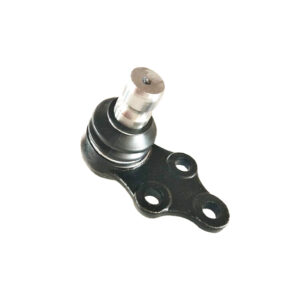Press-In Ball Joints: Press-in ball joints are the more traditional type of ball joint, commonly used in older vehicles and some modern applications. As the name suggests, these ball joints are pressed into the control arm or steering knuckle, creating a tight fit. They typically consist of a ball stud with a tapered end that fits into a matching tapered hole in the control arm or steering knuckle. Press-in ball joints may require special tools or equipment for installation and removal.
Bolt-On Ball Joints: Bolt-on ball joints are a more modern design and are frequently used in newer vehicles. These ball joints feature a threaded stud that attaches to the control arm or steering knuckle using a nut and bolt. They often have a larger ball stud and a flanged housing to provide increased strength and durability. Bolt-on ball joints are generally easier to install and remove than press-in ball joints since they don't require specialized tools.
It's worth noting that the specific design and construction of ball joints can vary depending on the vehicle's make, model, and suspension system. Some vehicles may use a combination of press-in and bolt-on ball joints in different locations within the suspension system. Additionally, advancements in suspension technology have led to the development of sealed or greasable ball joints, which vary in terms of maintenance requirements and longevity.
Regular inspection and maintenance of ball joints are essential to ensure optimal performance and safety. Over time, ball joints may wear out due to factors like normal wear and tear, road conditions, and lack of lubrication. If a ball joint becomes worn or damaged, it can result in poor steering control, suspension issues, and potential safety hazards. Therefore, it's important to consult the vehicle manufacturer's guidelines and seek professional assistance if you suspect any issues with your ball joints.
Worn or damaged ball joints can have a significant impact on vehicle handling and safety. Here are some ways in which worn or damaged ball joints can affect a vehicle:
Steering Instability: Ball joints play a crucial role in maintaining proper alignment and stability of the front suspension. When ball joints are worn or damaged, they can cause excessive play or looseness in the suspension system. This can result in steering instability, causing the vehicle to feel loose or wander while driving. The steering may become less responsive, and the driver may experience difficulty maintaining control of the vehicle.
Suspension Noise: Worn ball joints can produce noticeable noise, function of ball joints such as clunking, popping, or creaking sounds. These noises may occur when going over bumps, during cornering, or when the vehicle is in motion. The noise is typically caused by the excessive movement or play in the ball joint, indicating that it is no longer providing the necessary support and stability to the suspension system.
Uneven Tire Wear: Defective ball joints can affect the alignment of the wheels. When the ball joints wear out, they can allow the suspension components to move in ways they shouldn't, leading to improper wheel alignment. This misalignment can cause uneven tire wear, where certain areas of the tire tread wear down more quickly than others. If left unaddressed, it can result in the need for premature tire replacement and compromised handling.
Reduced Braking Performance: Worn ball joints can negatively impact braking performance. When ball joints are excessively worn, they can alter the suspension geometry, affecting the alignment between the wheels and the braking system components. This can lead to uneven brake pad wear, reduced brake effectiveness, and longer braking distances. In extreme cases, it may even affect the vehicle's ability to stop safely.
Increased Tire Stress: Faulty ball joints can put additional stress on the tires. The compromised suspension alignment can cause the tires to experience uneven loading and excessive forces during cornering or driving over uneven road surfaces. This can accelerate tire wear, reduce tire life, and potentially increase the risk of tire failure, such as blowouts.
Safety Concerns: Worn or damaged ball joints pose significant safety concerns. As the ball joints deteriorate, the risk of complete failure increases. If a ball joint were to fail while the vehicle is in motion, it can cause a sudden loss of control, leading to accidents or collisions. Therefore, addressing worn or damaged ball joints promptly is crucial to maintain safe vehicle operation.
If you suspect any issues with your ball joints, it is recommended to have a professional mechanic inspect and replace them if necessary. Regular inspection and maintenance of the suspension system, including the ball joints, are essential to ensure safe and reliable vehicle operation.

Copyright:@2020-2021
Comments Please sign in or sign up to post.
0
0 of 500 characters used